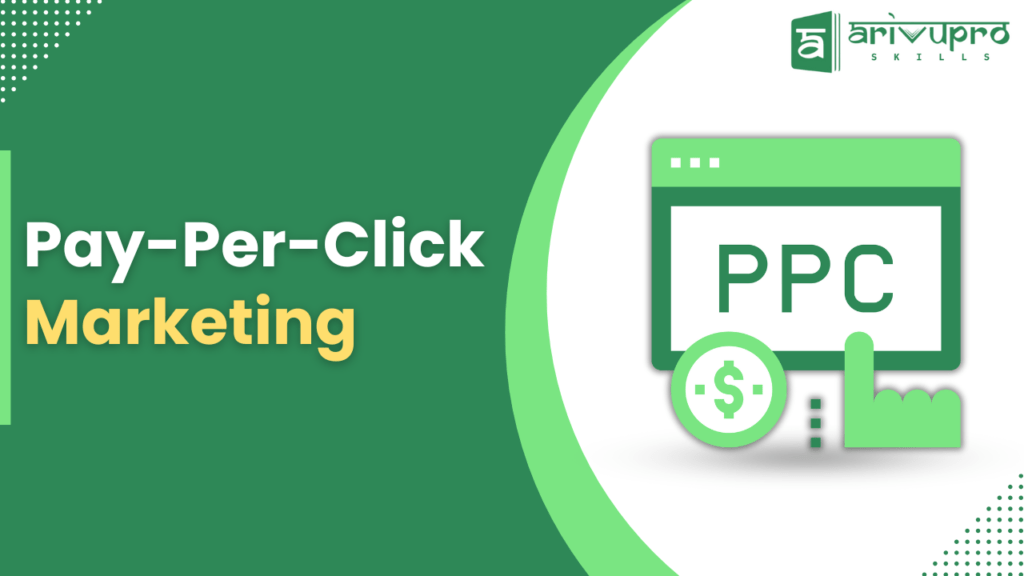Pay-Per-Click Marketing

If you’ve ever searched for something on Google and noticed ads at the top of the results page, you’ve encountered PPC in action. PPC, or Pay-Per-Click, is a popular digital marketing strategy used by businesses to attract traffic and generate leads. But what exactly is PPC, and how can it benefit your business? In this blog, we’ll explore the ins and outs of PPC marketing, including its role in performance marketing and how it fits into your overall digital strategy.
What is PPC?
At its core, PPC full form is Pay-Per-Click, which is a form of online advertising where advertisers pay a fee each time one of their ads is clicked. It’s a way of buying visits to your site, rather than earning them organically. Essentially, you place bids on specific keywords relevant to your product or service, and when someone searches for those keywords, your PPC ads can appear in prominent places like the top of search engine results pages.
How Does PPC Work in SEM Marketing?
PPC marketing is an integral part of SEM marketing (Search Engine Marketing). While SEO (Search Engine Optimization) focuses on organic traffic, SEM includes both paid and organic strategies. In PPC, businesses bid on keywords, and search engines like Google use an auction system to determine which ads are shown based on relevance and the bid amount. When a user clicks on the ad, the advertiser is charged, hence the term Pay-Per-Click.
Benefits of PPC in Performance Marketing
PPC is a powerful tool in performance marketing, where businesses only pay for measurable results. Here are a few key benefits:
- Instant Traffic: Unlike SEO, which takes time to build, PPC ads can start driving traffic to your site as soon as the campaign is live.
- Highly Targeted Audience: PPC allows businesses to target specific audiences based on keywords, location, device, and even time of day.
- Cost-Effective: Since you only pay when someone clicks your ad, you’re directly paying for results.
- Data-Driven Insights: PPC platforms like Google Ads offer detailed analytics on impressions, clicks, and conversions, enabling businesses to refine their campaigns and optimize for better performance.
Types of PPC Ads
PPC comes in various forms, each designed to reach users in different ways:
- Search Ads: These are the most common type, appearing at the top of search engine results when users search for relevant keywords.
- Display Ads: Banner-style ads displayed on websites within a network, reaching users as they browse the web.
- Shopping Ads: Product-based ads that show up in search results with images and pricing, ideal for e-commerce.
- Video Ads: Displayed on video platforms like YouTube, these ads are highly engaging and effective for branding.
How to Get Started with PPC
Starting with PPC marketing is straightforward but requires a clear strategy. Begin by selecting the right platform, such as Google Ads or Bing Ads. Research and identify relevant keywords, create compelling ad copy, and set a budget. Monitor your campaigns regularly, adjusting bids and keywords to maximize performance. If you’re new to PPC, consider starting with a modest budget and scaling up as you see results.
Why PPC is Important for Your Digital Strategy
In the competitive digital landscape, PPC ads are a must-have for businesses looking to stand out. They provide instant visibility and can complement other marketing strategies like SEO, content marketing, and social media efforts. As part of a larger performance marketing strategy, Pay-Per-Click ensures that every dollar you spend is accounted for, offering clear insights into what works and what doesn’t.
Conclusion
Understanding what PPC is and how it fits into your overall marketing strategy is crucial for growing your business online. Whether you’re looking to drive traffic, generate leads, or boost sales, Pay-Per-Click marketing offers a reliable and cost-effective solution. With the right approach and continuous optimization, PPC marketing can deliver outstanding results for your business.
Now that you know the basics of PPC, it’s time to explore how you can incorporate this powerful tool into your digital strategy!
FAQs
Answer: PPC works on a bidding system where advertisers select keywords related to their products or services. When users search for those keywords, ads are displayed in the search engine results. Advertisers are charged a fee each time someone clicks on their ad. The cost per click (CPC) is determined by factors like keyword competition and ad relevance.
Answer: The most popular platforms for PPC advertising include:
Google Ads: The largest and most widely used platform for search ads.
Bing Ads: Similar to Google Ads but targets Bing and Yahoo search engines.
Facebook Ads: Allows businesses to run PPC ads targeted by demographics, interests, and behaviors.
Instagram Ads: PPC ads on Instagram are run through Facebook Ads Manager.
LinkedIn Ads: Focused on B2B PPC advertising for professionals and companies.
Answer: There are several types of PPC ads, including:
Search Ads: These appear at the top or bottom of search engine results pages (SERPs).
Display Ads: Banner ads that appear on websites within Google’s Display Network.
Shopping Ads: Product ads that show up in search results with images and prices (ideal for e-commerce).
Video Ads: Displayed before or during videos, often seen on platforms like YouTube.
Remarketing Ads: Ads shown to users who have previously visited your website, encouraging them to return.
Answer: PPC involves paying for ads to appear on search engine results pages, while SEO (Search Engine Optimization) focuses on improving a website’s organic rankings without paid ads. PPC delivers immediate traffic through paid efforts, while SEO is a longer-term strategy to build organic visibility and traffic.

